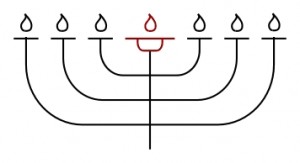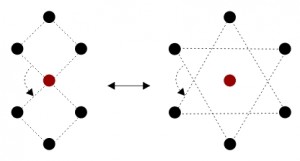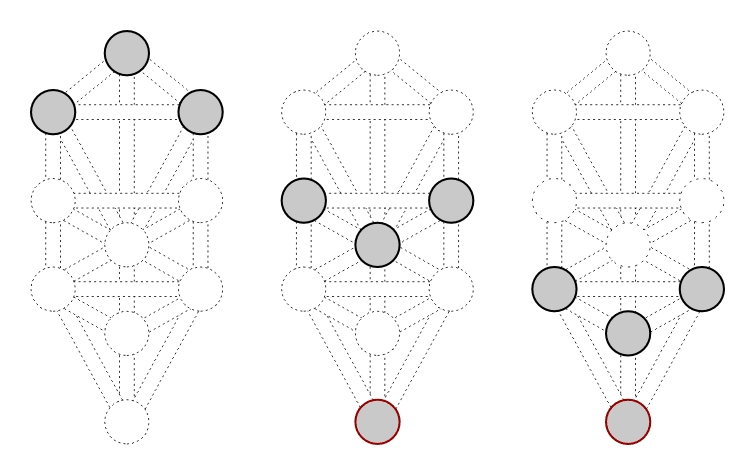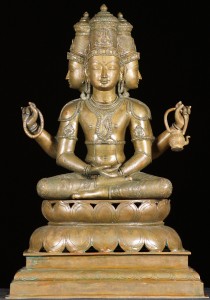Introduction
In the commentary on stanza IV śloka 2 (SD I, 88), it is described that, out of the sacred four, the primordial seven are produced:
They are the eternal tathāgatas or dhyāni buddhas of tantric Buddhism, or, as they are called most often in the SD, dhyān chohans. Note that the term dhyān chohan is also used in the SD in a broader sense, meaning deva or elemental spirit. In Buddhism the tathāgatas are eternal and unevolving. In SD I, 88 it is stated that they are latent in pralaya, and active during manvantara.
The Tetraktys
The sacred four are described as the tetraktys, the “holy tetrad”. In The Universal Over-Soul we have found that the sacred four are the four highest universal principles taken together. They are also called the self-existent one, svāyambhuva, or nārāyaṇa. Further, in the context of Kabbalism, they are called the tetragrammaton, which is the Hebrew four letter word IHVH, and Adam Kadmon, the heavenly man. (SD II, 595) In the note in SD I, 99n we find:
The word Logos is generally used by HPB for the manifested Logos, which is what we have called earlier the Second Logos. Further, in SD II, 599 we find:
Two Possible Misunderstandings
Later in the SD however, the tetragrammaton is identified with the “lower quaternary”. In CW X, 357 (Transactions of the Blavatsky Lodge), we find:
We must conclude that the term tetragrammaton is not used consequently in the SD. Whenever it is used we must ask ourselves whether it refers to the “higher” or the “lower” quaternary.
In the same location (CW X, 357), the tetraktys is seemingly identified with the First Logos:
In this case we can see that this passage does not describe the unmanifested logos which we have called the First, but the sacred four, the tetraktys, which manifests itself and retires at the end of the manvantara, which is indeed our Second Logos.
The Cube Unfolded and the Double Quaternary
In the SD, HPB does not provide an exact mechanism of how the primordial seven are produced from the sacred four. Two different symbolic connections between the four and the seven are given, one of which refers to the 1875 work of J. Ralston Skinner, Key to the Hebrew-Egyptian Mystery in the Source of Measures. On p. 50 of this work is described that when a cube is folded open, a cross may be formed consisting of one bar of 3 squares and another bar of 4 squares. One square, common to the horizontal and vertical bars, may be counted twice. So we have the cube folded open symbolically representing the equation 6 = 3 + 4.
 A similar symbolic representation is given on p. 51 of the same work, where the menorah (mənorāh) of the Jewish temple is described as having four arms on each side, the middle arm being in common to both sides, or projected onto itself, so representing the equation 4 + 4 = 7.
A similar symbolic representation is given on p. 51 of the same work, where the menorah (mənorāh) of the Jewish temple is described as having four arms on each side, the middle arm being in common to both sides, or projected onto itself, so representing the equation 4 + 4 = 7.
The other symbolic connection between the four and the seven, HPB gives in SD II, 599, apparently quoting Johannes Reuchlin, from his 1517 work De Arte Cabalistica:
 Here we have the equation 4 x 2 = 7. A representation of this can be seen in the following diagram. We can see that there is an equivalence between the double square and the symbol of the “seal of Solomon”, the centre principle being projected onto itself.
Here we have the equation 4 x 2 = 7. A representation of this can be seen in the following diagram. We can see that there is an equivalence between the double square and the symbol of the “seal of Solomon”, the centre principle being projected onto itself.
It seems however, that HPB quoted a large passage from the 1875 work of George Oliver, The Pythagorean Triangle, and not directly from Reuchlin. Oliver fails to provide the right page reference, and I have not been able to find the passage in De Arte Cabalistica. On p. 104 of The Pythagorean Triangle, we find:
Both Oliver and Reuchlin are quoting from Hierocles on this matter. If we go back to Hierocles’ Commentary on the Golden Verses of Pythagoras, in the 1853 edition of F.G.A. Mullachius, we find on p. 128, line 9, the quote on the “arithmetical mean” of the monad and the heptad, being the tetrad. (SD II, 599)
What follows (in lines 17-18) is
“and the eight from the twice four” (2 x 4 = 8), instead of “the tetrad doubled makes the hebdomad”. In this edition, the ‘ is missing after the δ.
In SD II, 599 there is another quote, also with a faulty page reference, apparently from Plutarchus’ De Animae Procreatione. This quote is also used in William Wynn Westcott’s work Numbers, their Occult Power and Mystic Virtues, which was published as a book in 1890, but written in 1883. In Wynn Westcott’s work the passage looks like:
So the two most significant elements concerning the double quaternary as yet prove to be unfounded: the Pythagorean world being a double Quaternary, and the hebdomad being a tetrad doubled. Returning to the equations, the 6 = 3 + 4, the 4 + 4 = 7 and the 4 x 2 = 7: in this context they all seem to express the same idea, that the primordial seven are “emanated” by the sacred four, so that, on the moment the fourth aspect comes into existence, the three eternals together with the fourth principle become a manifested tetrad, that is the Second Logos. The three are “mirrored” to become a new triad, while the fourth principle is unchanged, or, from a different perspective, the tetrad is mirrored to become a new tetrad, while the fourth principle is “counted double”, or projected onto itself.
The Ten and Seven Sefiroth
In the note in SD I, 99*, we find:
and in SD I, 98:
From these two quotes, we may derive that in kabbalistic terms, in the tree of life, the three eternals are the three highest sefiroth (ISO 259: səp̄irōṯ), kĕṯĕr (səp̄irāh), ḥoḵəmāh and bināh. These three are emanated to become three manifested principles, being the three middle sefiroth, ḡəḇurāh, ḥĕsĕd and ṯip̄əʾĕrĕṯ. They are apparently mirrored (or transposed) downward to form the three lower sefiroth, hōd, nĕṣah and iəsōd. The lowest sefirah, maləkuṯ, corresponds to our fourth principle, according to HPB.
The Four and Seven Elements and Their Atoms
In SD II, 587 it is stated that the sacred four are identical to the four elements:
Also in HPB’s quote from Wynn Westcott (above), attributed to Plutarchus, the “second quaternary” represents the “sensible world”, forming the Pythagorean “kosmos” of the four elements. In SD I, 82 we find how the first four principles should relate to the four elements:
The “primal centres of Forces” are called atoms, or aṇu in Sanskrit literature. They later become the elements in the sense that the atoms are the bases of the four and seven different types of matter in the universe. They are all meta-physical except the seventh, which is the domain of present-day physics. Its primal centre of force is the ultimate physical atom.
In SD I, 216, in a quote from the ancient “Commentary”, the elements are summed up alongside the various hierarchies of elemental entitities:
Four-Faced Brahmā
 As is noted in the SD in several places (f.e. SD I, 542), Aṇu, the Sanskrit word for atom, is also a name of Brahmā. In an earlier article On the Eternal Germ we have been looking at quotes from various versions of the story of the birth of four-faced Brahmā, the universe, born from the navel of Viṣṇu. In Bhāgavat Purāṇa 3.8.16 (GRETIL) for example, we find:
As is noted in the SD in several places (f.e. SD I, 542), Aṇu, the Sanskrit word for atom, is also a name of Brahmā. In an earlier article On the Eternal Germ we have been looking at quotes from various versions of the story of the birth of four-faced Brahmā, the universe, born from the navel of Viṣṇu. In Bhāgavat Purāṇa 3.8.16 (GRETIL) for example, we find:
An English rendering of Eugène Burnouf’s 1840 French translation (t. 1, p. 191-192) would be something like:
In this verse, a connection is made between the faces and the cardinal directions. In SD II, 464, the four faces are identified with the higher tetragrammaton. In Transactions of the Blavatsky Lodge (TBL, cf. CW X), on p. 71-72, most of the connections we have found so far in this article are summarised, and in the 2010 edition by Michael Gomes, The Secret Doctrine Commentaries, on p. 390, we also find that four-faced Brahmā is identified with the (higher) tetragrammaton:
Summary of the Four and Seven Universal Principles
Enumerating all concepts (tetrads) we have found to be related, or analogous, to the sacred four, we have: the (higher) tetraktys, the self-existent one, the first four dhyān chohans (four sons, four first-born), the four highest universal principles (7th-4th), the (higher) tetragrammaton (IHVH), Adam Kadmon (heavenly man), the Second Logos, the demiurg, the higher quaternary, the four faces of Brahmā, and the four cardinal directions.
Enumerating all the sevenfolds we have found to be related to the sacred four, we have: the primordial seven, the seven dhyān chohans (tathāgatas, dhyāni buddhas, archangels, sons, fighters), seven universal (cosmic) principles, arms of the menorah of the Jewish temple, the double quaternary, the elements, sefiroth, seven primal centres of forces, atoms, aṇu, the seven types of matter in the universe, and the seven planes of the universe.
We have not been able to trace here, the individual correspondences for each of these in the SD, but some individual items are listed reliably. In Esoteric Instruction I in CW XII, 658, the universal principles are also listed, as “macrocosmic states of consciousness”, and “elements of manifested macrocosm”. They are added here, in the following table.
| Universal Principles | Macrocosmic States | Elements | ||
| SD II, 596 | CW XII, 658 | SD I, 216 | ||
| 7 | The Unmanifested Logos | Ātmic | Fire | |
| 6 | Universal (latent) Ideation | Alayic | AEther | |
| 5 | Universal (or Cosmic) active Intelligence | Mahātic | Water | |
| 4 | Cosmic (Chaotic) Energy | Fohatic | Air | |
| 3 | Astral Ideation, reflecting terrestrial things | Jīvic | ||
| 2 | Life Essence or Energy | Astral | ||
| 1 | The Earth | Prakṛitic |
Category: Atom (anu), Brahma, Dhyan Chohans, Elements, Mahat, Sefiroth, Tetragrammaton, Tetraktys | 1 comment